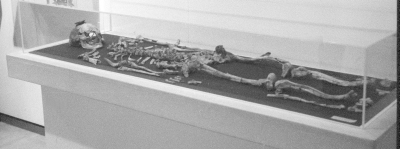Dr Johnathan Musgrave
Retired Senior Lecturer in Anatomy (Oral Biology)
University Senior Research Fellow
j.h.musgrave@bristol.ac.uk
I am currently working towards the publication of reports on the human skeletal remains from the following archaeological sites in Greece.
| Site | Brief description | Age | Excavator | Publication plans |
|---|---|---|---|---|
| Myrtos Pyrgos (Crete) | Minoan residential site with adjoining communal tomb and ossuary on the south east coast of Crete. Mainly adult male burials, reflecting interesting mortuary practices. | Bronze Age. Second millennium BC | Mr Gerald Cadogan | Mr Cadogan’s final report on the site |
| Lefkandi (Evvoia) | Toumba cemetery. Mainly high status cremations, plus inhumed ‘Queen of Lefkandi’. An important site on account of its trading links with Western Asia.
Report completed and awaiting publication. |
Early Iron Age. First millennium BC | The late Mr Mervyn Popham and Dr Irene Lemos | Dr Lemos’s final report on the cemetery |
| Koukos(Chalkidiki) | Remote mountain settlement site with nearby cist grave cemetery. Interesting but poorly preserved cremations. | Early Iron Age. First millennium BC. | Dr Jill Carington Smith. | Dr Carington Smith’s final report on the site. |
| Phoinikas(Thessaloniki) | High status cremations from a Macedonian tomb in an eastern suburb of Thessaloniki.
Draft report completed. |
4th century BC | Dr Maria Tsibidou | Annual of the BritishSchool at Athensor an appropriate Greek journal |
| Vergina (WesternMacedonia) |
NεkροtαΦέioTάΦoς ( K3), a robbed, probably royal, cist tomb containing remains of a young female aged 20-25, an adolescent female aged c. 13, and a child of unknown sex aged 6-7 years. Draft report completed. |
4th century BC | Dr Angeliki Kottaridi | Dr Kottaridi’s final report on the tomb |
Recent Publications
- Musgrave JH (2005). An anthropological assessment of the inhumations and cremations from the Early Iron Age cemetery at Torone. In: “The Early Iron Age Cemetery at Torone”; 243-315. Editor: JK Papadopoulos. Los Angeles: Cotsen Institute of Archaeology, UCLA.
- Roberts A, Robson-Brown K, Musgrave JH, Leslie I (2006). A case of bilateral scapholunate advanced collapse in a Romano-British skeleton from Ancaster. International Journal of Osteoarchaeology 16 (3): 208–20 (doi:10.1002/oa.817. ISSN 1099-1212).
- Papazoglou-Manioudaki L, Nafplioti A, Musgrave JH, Neave RAH, Smith D, Prag AJNWP (2009). Mycenae Revisited Part 1. The Human Remains from Grave Circle A: Stamatakis, Schliemann and Two New Faces from Shaft Grave VI. Annual of the British School at Athens 104: 233-77.
- Robson Brown K, Silver IA, Musgrave JH, Roberts AM (2010). The use of µCT technology to identify skull fracture in a case involving blunt force trauma. Forensic Science International 201 (http://dx.doi.org/10.1016/j.forsciint.2010.06.013).
- Musgrave J, Prag AJNW, Neave R, Fox RL, White H. (2010). The Occupants of Tomb II at Vergina. Why Arrhidaios and Eurydice must be excluded. Int J Med Sci 7: s1-s15 (http://www.medsci.org/v07p00s1.pdf ).

Cremated skeleton of Philip II of Macedon, the father of Alexander the Great. Figure13 in Musgrave et al. (2010). Photo JHM.